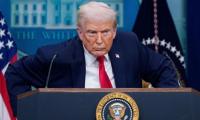The longest year
There was great temptation to write about August 29 as ‘the longest day’ on account of the IMF’s anxiously awaited decision on its Extended Fund Facility for Pakistan. Anxiety turned into anguish with the disclosure that a major political party governing Khyber Pakhtunkhwa (KP) and Punjab had tried to place hurdles in the loan’s approval.
Time difference between Islamabad and Washington prolonged the wait. It was only late in the night of the 29th and early hours of the 30th that news tickers began to announce the IMF’s favourable decision, which averted the danger of the possible default by Pakistan.
The development in Washington has brightened the horizon to some extent, but the broader picture looks murky. The year 2022 has so far witnessed tumultuous developments producing great uncertainty about the country’s future.
Some experts have already compared this year to 1971, the bleakest year of our country’s history. The events which began unfolding in March 1971 eventually led to the breakup of Pakistan and the emergence of Bangladesh, facilitated by our arch enemy India. These concerns are not misplaced if one looks at the visible fracture among the people and the body politic.
The split between the supporters and opponents of Imran Khan has led to fissures among communities as well as families. It is the first time that those who reside mostly in ‘gated communities’ are also politically divided.
Ever since the removal of former prime minister Junejo in 1988, the country’s powerful quarters somehow took upon the role of rotating the two major parties at the helm at regular intervals. Once Gen Musharraf's rule ended, this practice of rotation was resumed from 2008 onwards.
In the meantime, something extraordinary happened with Nawaz Sharif’s disqualification in 2017. Even though the PML-N completed its five-year term in office, the top leader’s absence enabled an otherwise struggling third party to come to power in Punjab and the centre after the 2018 general elections.
The anxiety within power-brokers to bring a Mr Clean to power, ending a stranglehold on power for pelf practices, resulted in a new coalition led by Imran Khan, which surprisingly continued to act like the opposition, resembling Benazir Bhutto’s first term as prime minister. Rather than focusing on the myriad issues of the state, the first-time premier called opposition leaders thieves on a daily basis. Strains began to appear after three years of a roller-coaster ride of the much-vaunted hybrid system.
Guided by a playbook, it was decided to pull the rug from under Khan’s feet by undoing the coalition cobbled three years earlier. Surprise! Khan refused to play by the rules of the game. He first tried to block the no-confidence motion. Failing to do so, he vociferously attributed his removal from power to a foreign-backed conspiracy.
Imran Khan now feels insecure to sit out another year when the general election is due. He has worked hard to mobilize popular support to prove that the people are still with him. But his insecurity is increasing with each passing month. He has been out of office for five months despite his frequent jalsas loaded with threats to his opponents as well as state officials including a woman judge.
Imran Khan has threatened to bring the government in Islamabad to a halt with the help of his popular march, something he was unable to do with his sit-in of 2014. Luckily for the ruling coalition and its backers, Imran is facing disqualification from elected office on more than one count. If history is a guide, Pakistanis are not attracted by street agitation beyond a short period.
Two episodes tested the patience of the country’s powerful quarters. Shahbaz Gill’s seditious statements and Shaukat Tarin’s attempt to derail the IMF’s decision on reviving the loan facility. Gill languishes in jail while on trial, and Tarin’s awkward sabotage attempt was thoroughly exposed. However, Imran keeps pushing his populist orations as if they are the key to his survival.
The overall situation remains fluid. The PDM government led by Shehbaz Sharif has managed to survive Khan’s daily assaults on its credentials. The coalition received a setback with the PTI’s return to power in Punjab after it won the by-elections in July. The former prime minister has threatened to keep challenging the centre’s writ through the PTI governments in KP and Punjab.
There is one question occupying most minds: where is this ongoing free-for-all show going to lead? Imran is raising the tension level to new heights by organizing jalsas where he spews venom against all those standing in his way. He demonstrated his high popularity by raising Rs5 billion in contribution pledges in a telethon held to collect aid for flood affectees.
It is surprising that a renowned sportsman is completely oblivious of the rules of another highly competitive field – politics. Does he really believe that the ‘umpire’s’ finger could go up only for him on account of being virtuous? No, Mr Khan, self righteousness is not highly prized in politics or governance. You will be judged on delivery.
The stakes are extremely high as the chances of Imran Khan getting convicted in cases related to foreign funding, Toshakhana and more recently contempt of court and terror threat are quite high. These cases can lead to his disqualification even if the terror charge is not vindicated. Will the PTI leader resort to appeals against his disqualification or try to bring the country to a halt with the help of a mass movement?
If we go by Khan’s exhortations for a mass movement, he must be extremely worried about his chances of participating in the next election. This could lead to some desperate steps by the PTI, plunging the country into turmoil.
The prospects of seeing the longest year off in peace hang in balance.
The writer can be reached at: saeed.saeedk@gmail.com
-
 Alexander Skarsgard Breaks Silence On Rumors He Is Bisexual
Alexander Skarsgard Breaks Silence On Rumors He Is Bisexual -
 King Charles Faces Rift With Prince William Over Prince Harry’s Invictus Games
King Charles Faces Rift With Prince William Over Prince Harry’s Invictus Games -
 Elon Musk’s Critique On ChatGPT Safety Draws Sharp Response From Sam Altman
Elon Musk’s Critique On ChatGPT Safety Draws Sharp Response From Sam Altman -
 Katherine Ryan Takes Aim At Brooklyn Beckham In Fierce Defense Of His Parents
Katherine Ryan Takes Aim At Brooklyn Beckham In Fierce Defense Of His Parents -
 How Timothy Busfield, Melissa Gilbert Really Feel After Release From Jail
How Timothy Busfield, Melissa Gilbert Really Feel After Release From Jail -
 OpenAI, Bill Gates Launch ‘Horizon 1000’ To Transform AI Healthcare In Africa
OpenAI, Bill Gates Launch ‘Horizon 1000’ To Transform AI Healthcare In Africa -
 Prince Harry Receives Praises For Exposing Dark Side Of British Tabloids
Prince Harry Receives Praises For Exposing Dark Side Of British Tabloids -
 Andrew Forces Beatrice, Eugenie To Lose $60 Million Safety Net Saved For Retirement
Andrew Forces Beatrice, Eugenie To Lose $60 Million Safety Net Saved For Retirement -
 Nvidia CEO Jensen Huang To Visit China To Push Re-entry Into AI Chip Market
Nvidia CEO Jensen Huang To Visit China To Push Re-entry Into AI Chip Market -
 U.S. On Verge Of Losing Measles-free Title Due To Outbreak
U.S. On Verge Of Losing Measles-free Title Due To Outbreak -
 Harry Styles Excites Fans As He Announces Release Date Of New Song
Harry Styles Excites Fans As He Announces Release Date Of New Song -
 Japan’s Ex-PM Shinzo Abe’s Killer Is Set To Be Sentenced: How Much Punishment Could He Face?
Japan’s Ex-PM Shinzo Abe’s Killer Is Set To Be Sentenced: How Much Punishment Could He Face? -
 Prince Harry, Meghan Markle’s Return To UK Could Create Royal Family Dilemma
Prince Harry, Meghan Markle’s Return To UK Could Create Royal Family Dilemma -
 Prince Harry Turns Troubled With No Sense Of Home: ‘Isolation Is Getting To Him Mentally’
Prince Harry Turns Troubled With No Sense Of Home: ‘Isolation Is Getting To Him Mentally’ -
 Vitamin D Link To Respiratory Diseases Will Shock You
Vitamin D Link To Respiratory Diseases Will Shock You -
 A$AP Rocky Gives His Take On Children's Budding Personalities
A$AP Rocky Gives His Take On Children's Budding Personalities



